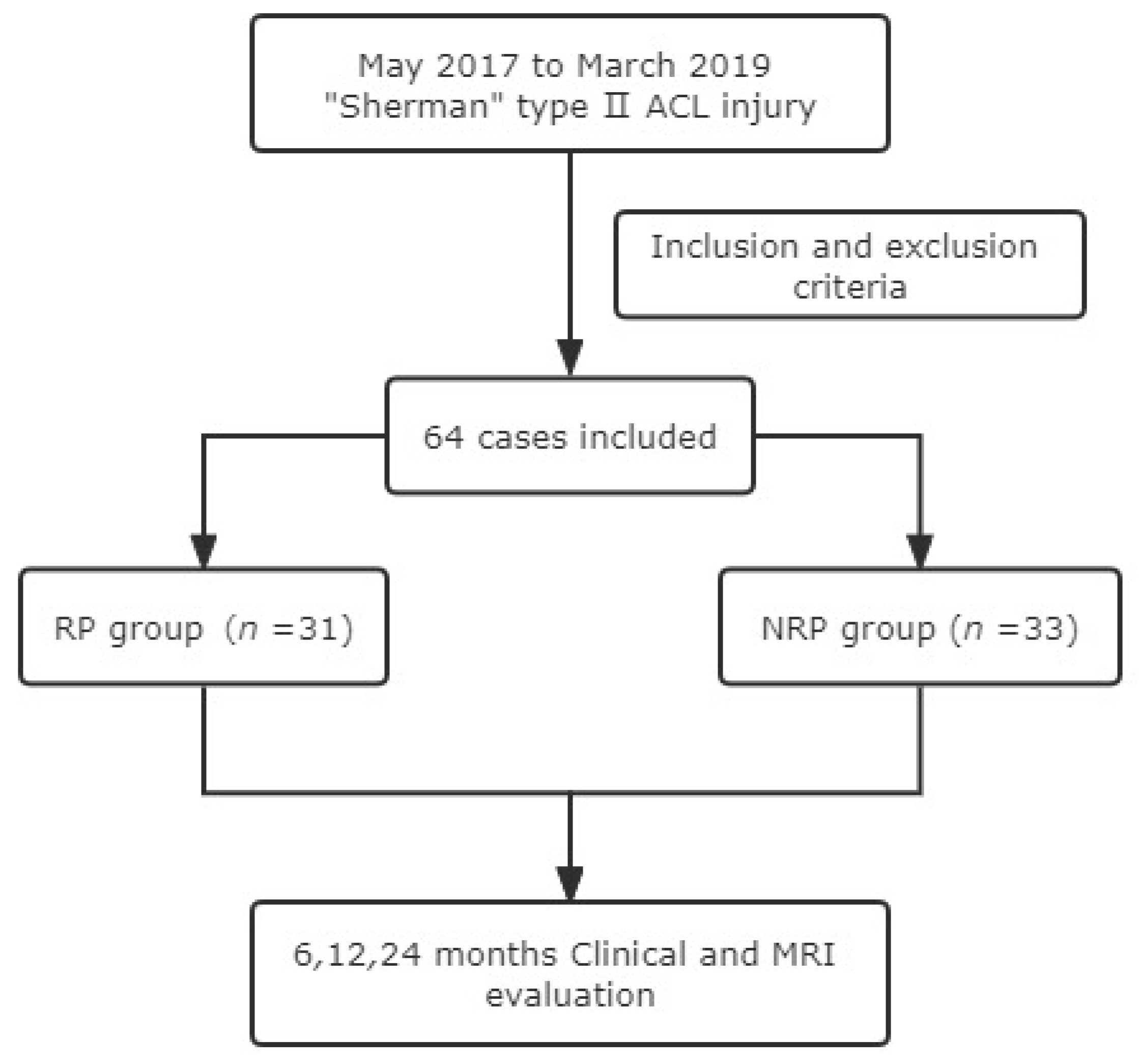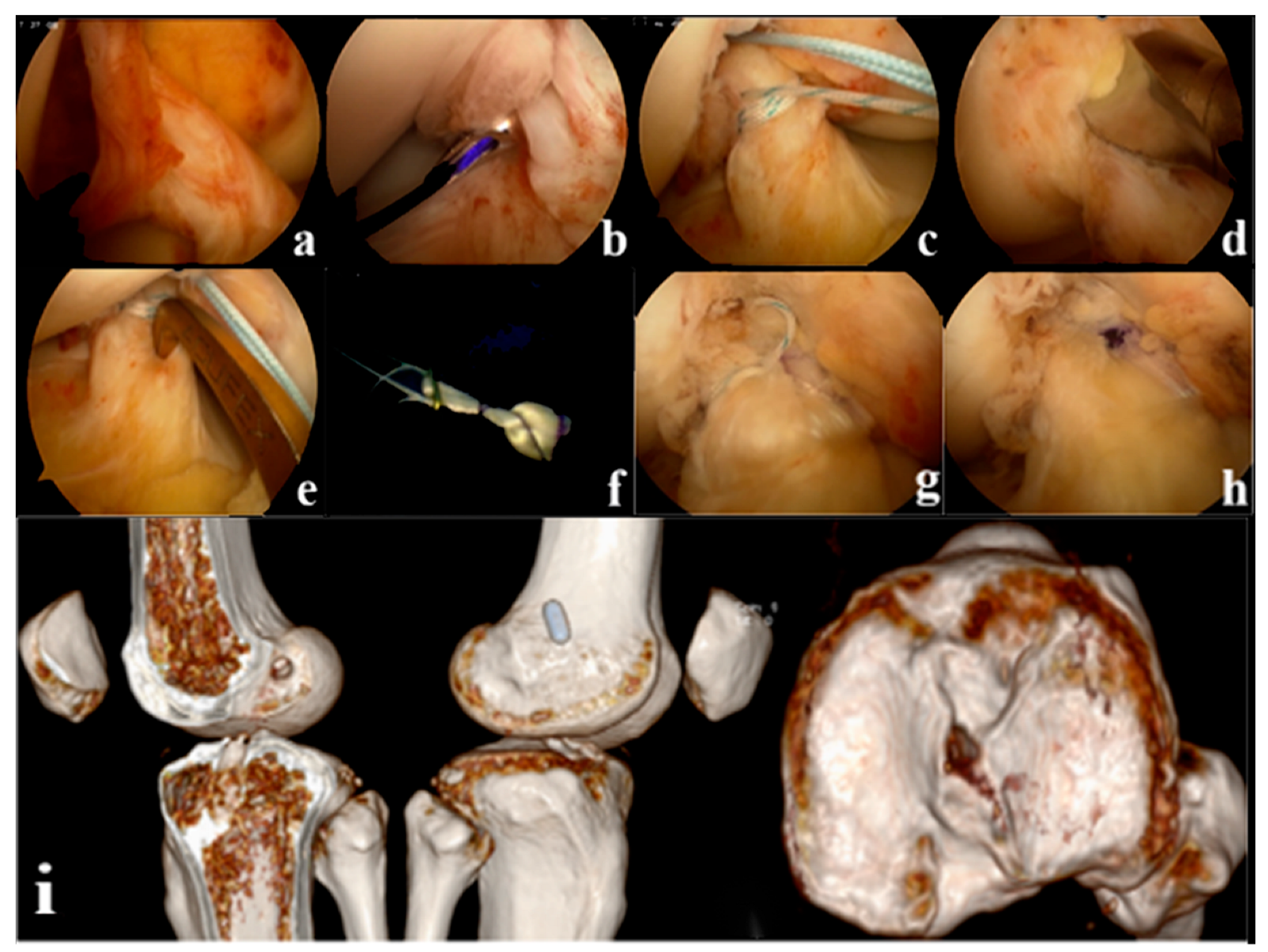Comparative Study of Graft Healing in 2 Years after “Tension Suspension” Remnant-Preserving and Non-Remnant-Preserving Anatomical Reconstruction for Sherman Type II Anterior Cruciate Ligament Injury
Abstract
1. Introduction
2. Materials and Methods
3. Surgical Technique
4. Rehabilitation Protocol
5. Clinical Assessment
6. Radiographic Evaluation
6.1. Signal/Noise Quatient (SNQ) Measurement
6.2. DTI Measurement
6.3. Statistical Analysis
7. Result
7.1. Clinical Functional Evaluation Results
7.2. Radiographic Results
8. Discussion
9. Limitation
10. Conclusions
Author Contributions
Funding
Institutional Review Board Statement
Informed Consent Statement
Data Availability Statement
Conflicts of Interest
References
- Chen, K.; Yin, L. In vivo motion of femoral condyles during weight-bearing flexion after anterior cruciate ligament rupture using biplane radiography. J. Sports Sci. Med. 2013, 12, 579–587. [Google Scholar] [PubMed]
- Leiter, J.R.; Gourlay, R. Long-term follow-up of ACL reconstruction with hamstring autograft. Knee Surg. Sports Traumatol. Arthrosc. 2014, 22, 1061–1069. [Google Scholar] [CrossRef] [PubMed]
- Sanford, B.A.; Zucker-Levin, A.R. Principal component analysis of knee kinematics and kinetics after anterior cruciate ligament reconstruction. Gait Posture 2012, 36, 609–613. [Google Scholar] [CrossRef] [PubMed]
- Deneweth, J.M.; Bey, M.J. Tibiofemoral joint kinematics of the anterior cruciate ligament-reconstructed knee during a single-legged hop landing. Am. J. Sports Med. 2010, 38, 1820–1828. [Google Scholar] [CrossRef]
- Tie, K.; Chen, L. The difference in clinical outcome of single-bundle anterior cruciate ligament reconstructions with and without remnant preservation: A meta-analysis. Knee 2016, 23, 566–574. [Google Scholar] [CrossRef]
- Nayak, M.; Nag, H.L. Ultrastructural characterization of cells in the tibial stump of ruptured human anterior cruciate ligament, their changes and significance with duration of injury. Med. Mol. Morphol. 2020, 53, 86–93. [Google Scholar] [CrossRef]
- Xie, H.; Fu, Z. Effects of remnant preservation in anterior cruciate ligament reconstruction: A systematic review and meta-analysis. Front. Surg. 2022, 9, 952930. [Google Scholar] [CrossRef]
- Wang, H.; Liu, Z. Is Remnant Preservation in Anterior Cruciate Ligament Reconstruction Superior to the Standard Technique? A Systematic Review and Meta-Analysis. Biomed. Res. Int. 2019, 2019, 1652901. [Google Scholar] [CrossRef]
- Jiang, L.; Zhang, L. The effect of proprioception training on knee kinematics after anterior cruciate ligament reconstruction: A randomized control trial. J. Back Musculoskelet. Rehabil. 2022, 35, 1085–1095. [Google Scholar] [CrossRef]
- Li, Z.; Zhang, L. Current concepts in arthroscopic reconstruction of anterior cruciate ligament with remnant preservation technique. Zhongguo Xiu Fu Chong Jian Wai Ke Za Zhi 2010, 24, 304–308. [Google Scholar]
- Nelson, C.; Rajan, L. Postoperative Rehabilitation of Anterior Cruciate Ligament Reconstruction: A Systematic Review. Sports Med. Arthrosc. Rev. 2021, 29, 63–80. [Google Scholar] [CrossRef] [PubMed]
- Ahn, J.H.; Wang, J.H. Anterior cruciate ligament reconstruction using remnant preservation and a femoral tensioning technique: Clinical and magnetic resonance imaging results. Arthroscopy 2011, 27, 1079–1089. [Google Scholar] [CrossRef]
- Zhu, W.; Wang, D. Anterior cruciate ligament (ACL) autograft reconstruction with hamstring tendons: Clinical research among three rehabilitation procedures. Eur. J. Orthop. Surg. Traumatol. 2013, 23, 939–943. [Google Scholar] [CrossRef]
- Ebert, J.R.; Smith, A. A comparison of the responsiveness of 4 commonly used patient-reported outcome instruments at 5 years after matrix-induced autologous chondrocyte implantation. Am. J. Sports Med. 2013, 41, 2791–2799. [Google Scholar] [CrossRef]
- Magnuson, J.A.; Platt, B.N. Patient-reported outcome scores following patellar instability surgery-high prevalence does not equal high responsiveness: A systematic review. Knee Surg. Sports Traumatol. Arthrosc. 2022, 30, 1453–1460. [Google Scholar] [CrossRef] [PubMed]
- Zhang, P.; Han, F. Local delivery of controlled-release simvastatin to improve the biocompatibility of polyethylene terephthalate artificial ligaments for reconstruction of the anterior cruciate ligament. Int. J. Nanomed. 2016, 11, 465–478. [Google Scholar] [CrossRef] [PubMed]
- Nayak, M.; Nag, H.L. Quantitative correlation of mechanoreceptors in tibial remnant of ruptured human anterior cruciate ligament with duration of injury and its significance: An immunohistochemistry-based observational study. J. Orthop. Traumatol. 2018, 19, 5. [Google Scholar] [CrossRef]
- Takahashi, T.; Kondo, E. Effects of Remnant Tissue Preservation on the Tendon Graft in Anterior Cruciate Ligament Reconstruction: A Biomechanical and Histological Study. Am. J. Sports Med. 2016, 44, 1708–1716. [Google Scholar] [CrossRef]
- Mellado, J.; Calmet, J. Magnetic resonance imaging of anterior cruciate ligament tears:reevaluation of quantitative parameters and imaging findings including a simplified method for measuring the anterior cruciate ligament angle. Knee Surg. Sports Traumatol. Arthrosc. 2004, 12, 217–224. [Google Scholar]
- Ntoulia, A.; Papadopoulou, F. Evaluation with contrast- enhanced magnetic resonance imaging of the anterior cruciate ligament graft during its healing process: A two- year prospective study. Skeletal Radiol. 2013, 42, 541–552. [Google Scholar] [CrossRef]
- Weiler, A.; Peters, G. Biomechanical properties and vascularity of an anterior cruciate ligament graft can be predicted by contrast—Enhanced magnetic resonance imaging. A two-year study in sheep. Am. J. Sports Med. 2001, 29, 751–761. [Google Scholar] [CrossRef] [PubMed]
- Cheng, W.; Chuandong, L. Graft Ligamentization after Anterior Cruciate Ligament Reconstruction and Its Influencing Factor. Chin. J. Sport. Med. 2020, 39, 97–103. [Google Scholar]
- Lee, B.I.; Kim, B.M. Does the tibial remnant of the anterior cruciate ligament promote ligamentization? Knee 2016, 23, 1133–1142. [Google Scholar] [CrossRef] [PubMed]
- Fukuda, H.; Asai, S. Inferior graft maturity in thePL bundle after autograft hamstring double-bundle ACL reconstruction. Knee Surg. Sports Traumatol. Arthrosc. 2019, 27, 491–497. [Google Scholar] [CrossRef]
- Liu, S.; Li, H. A Randomized Clinical Trial to Evaluate Attached Hamstring Anterior Cruciate Ligament Graft Maturity With Magnetic Resonance Imaging. Am. J. Sports Med. 2018, 46, 1143–1149. [Google Scholar] [CrossRef] [PubMed]
- Kosaka, M.; Nakase, J. Oblique coro⁃ nal and oblique sagittal MRI for diagnosis of anterior cruciate ligament tears and evaluation of anterior cruciate ligament remnant tissue. Knee 2014, 21, 54–57. [Google Scholar] [CrossRef]
- Ma, Y.; Murawski, C.D. Graft maturity of the reconstructed anterior cruciate ligament 6 months postoperatively: A magnetic resonance imaging evaluation of quadriceps tendon with bone block and hamstring tendon autografts. Knee Surg. Sports Traumatol. Arthrosc. 2015, 23, 661–668. [Google Scholar] [CrossRef] [PubMed]
- Pauzenberger, L.; Syre, S. “Ligamentization” in hamstring tendon grafts after anterior cruciate ligament reconstruction: A systematic review of the literature and a glimpse into the future. Arthroscopy 2013, 29, 1712–1721. [Google Scholar] [CrossRef]
- Van Dyck, P.; Froeling, M. Diffusion tensor imaging of the anterior cruciate ligament graft. J. Magn. Reson. Imaging 2017, 46, 1423–1432. [Google Scholar] [CrossRef]
- Chen, Y. Research on the Value of the Application of 3D-SPACE and DTI Techniques for the Magnetic Resonance of the Anterior Cruciate Ligament. Master’s Thesis, Dalian Medical University, Dalian, China, 2016. [Google Scholar]
- Yang, X.; Li, M. Diffusion tensor imaging for anatomical and quantitative evaluation of the anterior cruciate ligament and ACL grafts: A preliminary study. J Comput Assist Tomogr. 2014, 38, 489–494. [Google Scholar] [CrossRef]



| RP Group (n = 31) | NRP Group (n = 33) | T Value | p Value | |
|---|---|---|---|---|
| Age | 27.71 ± 7.24 | 27.26 ± 7.05 | −0.648 | n.s |
| Gender, Male/Female | 19/12 | 20/13 | n.s | |
| BMI, kg/m2 | 23.61 ± 1.22 | 23.46 ± 1.17 | −0.500 | n.s |
| Injured side, left/right | 11/20 | 14/19 | n.s |
| RP Group (n = 31) | NRP Group (n = 33) | t | p | |
|---|---|---|---|---|
| ± s) | ||||
| Preoperation | 49.3 ± 8.4 | 50.1 ± 7.8 | 1.568 | 0.122 |
| 6 months | 68.7 ± 7.9 | 66.8 ± 6.4 | 4.067 | 0.000 * |
| 12 months | 84.1 ± 6.3 | 82.5 ± 7.1 | 4.908 | 0.000 * |
| 24 months | 88.6 ± 4.8 | 86.5 ± 5.1 | 1.961 | 0.05 * |
| ± s) | ||||
| Preoperation | 51.2 ± 9.1 | 50.4 ± 10.1 | −1.377 | 0.174 |
| 6 months | 73.2 ± 6.3 | 72.4 ± 6.0 | 2.701 | 0.009 * |
| 12 months | 83.8 ± 5.4 | 81.4 ± 5.3 | 5.376 | 0.000 * |
| 24 months | 89.8 ± 4.7 | 87.6 ± 4.2 | 1.506 | 0.03 * |
| ± s) | ||||
| Preoperation | 2.2 ± 0.8 | 2.1 ± 0.9 | −0.394 | 0.693 |
| 6 months | 3.6 ± 0.6 | 3.5 ± 0.7 | −0.699 | 0.485 |
| 12 months | 5.3 ± 1.1 | 5.2 ± 0.8 | −1.753 | 0.080 |
| 24 months | 6.0 ± 0.7 | 5.8 ± 0.9 | −0.254 | 0.800 |
| RP Group | NRP Group | p Value | |||||||
|---|---|---|---|---|---|---|---|---|---|
| 6 Months | 12 Months | 24 Months | 6 Months | 12 Months | 24 Months | 6 Months | 12 Months | 24 Months | |
| Femoral side | 21.86 ± 7.51 | 17.32 ± 6.69 | 12.16 ± 7.08 | 29.45 ± 11.47 | 21.04 ± 7.96 | 17.31 ± 7.87 | p < 0.05 * | ||
| Middle segment | 11.98 ± 5.51 | 9.84 ± 6.01 | 9.32 ± 6.48 | 21.42 ± 9.31 | 18.69 ± 7.22 | 13.45 ± 6.92 | |||
| Tibial side | 10.02 ± 5.98 | 9.21 ± 5.23 | 9.95 ± 6.11 | 19.76 ± 8.56 | 13.18 ± 6.54 | 11.82 ± 6.96 | |||
| RP Group | NRP Group | p Value | |||||||
|---|---|---|---|---|---|---|---|---|---|
| 6 Months | 12 Months | 24 Months | 6 Months | 12 Months | 24 Months | 6 Months | 12 Months | 24 Months | |
| FA value | 0.329 ± 0.041 | 0.237 ± 0.032 | 0.161 ± 0.036 | 0.376 ± 0.043 | 0.250 ± 0.043 | 0.176 ± 0.029 | p < 0.05 * | ||
| ADC value | 2.812 ± 0.161 | 2.510 ± 0.143 | 2.012 ± 0.321 | 2.911 ± 0.159 | 2.621 ± 0.138 | 2.214 ± 0.291 | |||
Disclaimer/Publisher’s Note: The statements, opinions and data contained in all publications are solely those of the individual author(s) and contributor(s) and not of MDPI and/or the editor(s). MDPI and/or the editor(s) disclaim responsibility for any injury to people or property resulting from any ideas, methods, instructions or products referred to in the content. |
© 2023 by the authors. Licensee MDPI, Basel, Switzerland. This article is an open access article distributed under the terms and conditions of the Creative Commons Attribution (CC BY) license (https://creativecommons.org/licenses/by/4.0/).
Share and Cite
Sun, Y.; Huang, Z.; Zhang, P.; Xie, H.; Wang, C.; Deng, Z.; Chen, K.; Zhu, W. Comparative Study of Graft Healing in 2 Years after “Tension Suspension” Remnant-Preserving and Non-Remnant-Preserving Anatomical Reconstruction for Sherman Type II Anterior Cruciate Ligament Injury. J. Pers. Med. 2023, 13, 477. https://doi.org/10.3390/jpm13030477
Sun Y, Huang Z, Zhang P, Xie H, Wang C, Deng Z, Chen K, Zhu W. Comparative Study of Graft Healing in 2 Years after “Tension Suspension” Remnant-Preserving and Non-Remnant-Preserving Anatomical Reconstruction for Sherman Type II Anterior Cruciate Ligament Injury. Journal of Personalized Medicine. 2023; 13(3):477. https://doi.org/10.3390/jpm13030477
Chicago/Turabian StyleSun, Yijia, Zirong Huang, Pingquan Zhang, Huanyu Xie, Chen Wang, Zhenhan Deng, Kang Chen, and Weimin Zhu. 2023. "Comparative Study of Graft Healing in 2 Years after “Tension Suspension” Remnant-Preserving and Non-Remnant-Preserving Anatomical Reconstruction for Sherman Type II Anterior Cruciate Ligament Injury" Journal of Personalized Medicine 13, no. 3: 477. https://doi.org/10.3390/jpm13030477
APA StyleSun, Y., Huang, Z., Zhang, P., Xie, H., Wang, C., Deng, Z., Chen, K., & Zhu, W. (2023). Comparative Study of Graft Healing in 2 Years after “Tension Suspension” Remnant-Preserving and Non-Remnant-Preserving Anatomical Reconstruction for Sherman Type II Anterior Cruciate Ligament Injury. Journal of Personalized Medicine, 13(3), 477. https://doi.org/10.3390/jpm13030477






